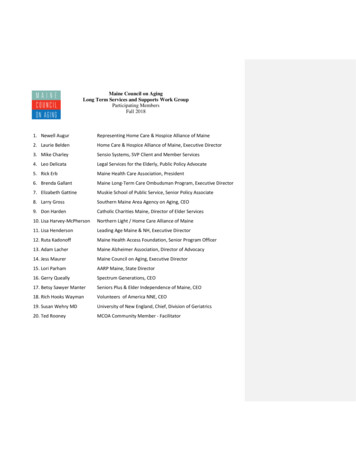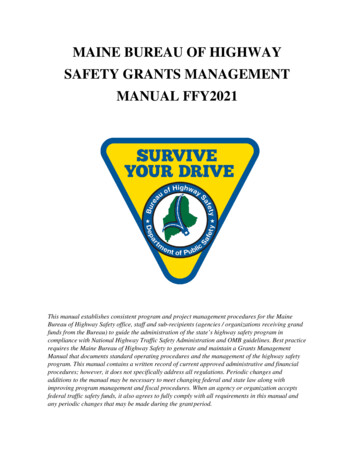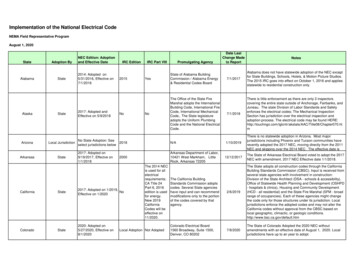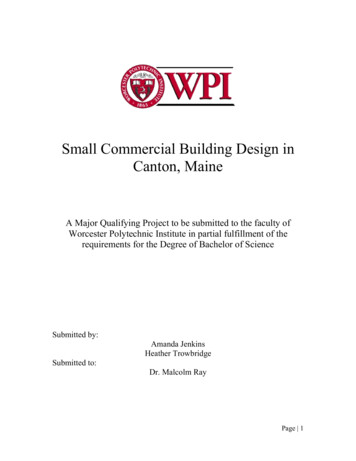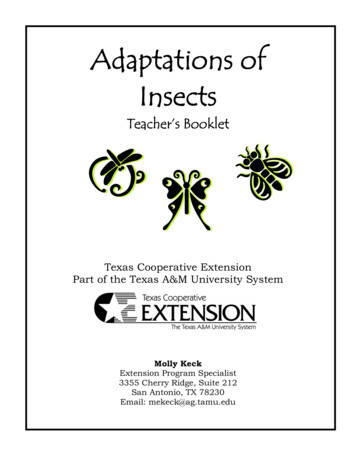
Transcription
Adaptations ofInsectsTeacher’s BookletTexas Cooperative ExtensionPart of the Texas A&M University SystemMolly KeckExtension Program Specialist3355 Cherry Ridge, Suite 212San Antonio, TX 78230Email: mekeck@ag.tamu.edu
PrefaceInsects have amazing adaptations that make each type unique and diverse.Insects are adapted for life in every environment imaginable. With theexception of deep in volcanoes, insects can be found everywhere. Insectadaptations include mouthparts, the ability to fly, leg types, and bodyshapes. Imagine if all insects looked exactly the same, ate exactly thesame food, and lived in exactly the same habitats. It would be impossiblebecause insects would compete too much and would not be able tosurvive.In this booklet are a variety of exercises designed to help educate yourstudents about adaptations by using insects as examples.1
Table of ContentsPreface1Lesson 1 – Insect AdaptationsActivity 1 – Maze37Lesson 2 – Insect Mouthpart AdaptationsActivity 2 – Insect Masks811Lesson 3 – Insect Adaptations to HabitatsActivity 3-1 – Matching Legs to HabitatsActivity 3-2 – Build an Insect182224Lesson 4 – Who is Adapted to Their EnvironmentActivity 4-1 – Adaptation Matching GameActivity 4-2 – Adaptation Word Search293335Wrap Up Group Activity36Wrap Up Crossword Activity37Glossary39
Lesson 1 - Insect AdaptationsOverview:Students will read the following passage in the classroom and then answerrelevant questions pertaining to the passage. The students will get an overviewabout of the term adaptation, and how insects may be adapted to theirenvironment.Instructions:Read the passage either in groups or as a class.Objectives:Students will know the term adaptation and will be able to recognizeadaptations that insects have developed to help them survive in theenvironment.TEKS:Science:2.2a, 2.2b, 2.5a, 2.6d, 2.8a3.2a, 3.2c, 3.2d, 3.8a, 3.8d, 3.9a, 3.9b,4.3a, 4.5a, 4.8a, 4.8b,5.3a, 5.5a, 5.9a, 5.9b, 5.9cMaterials:Handouts of reading exercise for Lesson 1Overhead copy of reading exercise for Lesson 1Wrap up questions for Lesson 1Activity 13
Lesson 1: Insect AdaptationsQuestions to Ask Before Reading the Passage:What is an adaptation?Can you think of some animals that are adapted to their environment?How are we adapted to our environment?Reading ExerciseInsects are adapted their environment in many ways. An adaptation is anadjustment to the environment so that an animal can fit in better and have abetter chance of living. Animals with heavy fur coats are adapted for coldenvironments. Animals that have webbed feet are adapted for living in thewater. Insects can also be adapted to their environment.Here are some adaptations insects can have:Insects can be camouflaged. Insects that look like their environment won’t beseen by predators such as birds and lizards. Some insects look like sticks, leaves,and thorns. This type of adaptation helps insect survive by blending in withtheir surroundings so they aren’t eaten or so that prey doesn’t see them hiding.Stink Bugs are the same color greenas the leaves they like to eat.Walking sticks look just likesticks or leaves.4
Insect antennae can be adapted to their environment.Insects with large eyes do not need extra help seeing andhave short antennae. Insects with long antennae probablyhave very little eyes. Think about an insect that lives indark places, what will their eyes and antennae look like?They will probably have small eyes because their world isdark, and eyes aren’t helpful. They will also probably havelong antennae to help them get around in the dark.Dragonflies have very largeeyes and very smallantennae.Insects can have adapted feet and legs. There are manydifferent types of insect legs such as jumping, digging,running, and swimming. These adaptations help themsurvive in the environment that they live in.Grasshoppers have long, strong hind legs that helpthem jump. This adaptation helps them get awayfrom predators, and jump over tall grasses.Insects can also have adapted mouthparts. This helpsthem eat their favorite foods better. There arechewing, sucking, lapping, and sponging mouthparts.House flies have spongingmouthparts to slurp up food.5
Wrap Up Questions:What is an adaptation? How an animal looks to help it fit into its environment.What are some ways insects can be adapted to their environment? Antennaeand eyes, legs, mouthparts, camouflaged.What would an insect’s antennae and eyes look like if it only lived in dark caves?Long antennae and small eyesWhat type of adaptation would an insect that lived in trees have? Camouflagedto look like leaves or sticks.6
Activity 1: MazeWendel the Whirligig Beetle is adapted for living in the water. He has long hindlegs for swimming and short front legs for grabbing food. Help Wendel find hisway back to his pond.StartEnd7
Lesson 2 - Insect Mouthpart AdaptationsOverview:Students will read the following passage in the classroom and then answerrelevant questions pertaining to the passage. The students will learn about thevarious insect mouthparts and how they are adapted for their environment.Instructions:Read the passage either in groups or as a classObjectives:Students will know the types of insect mouthparts. Students will be able torecognize what insects eat based on what type of mouthparts they have.TEKS:Science:2.2a, 2.2b, 2.5a, 2.6a, 2.6b, 2.6d3.2a, 3.2c, 3.2d, 3.5a, 3.5b, 3.8a, 3.8d, 3.9a, 3.9b4.2a, 4.8a, 4.8b5.2a, 5.9a, 5.9b, 5.9cMaterials:Handouts of reading exercise for Lesson 2Overhead copy of reading exercise for Lesson 2Wrap up questions for Lesson 2Activity 28
Lesson 2: Insect Mouthpart AdaptationsQuestions to Ask Before Reading the Passage:Do insects have more that one type of mouth?What types of mouthparts do insects have?How do their mouthparts help them eat and survive?Reading Exercise:Insects have many different types of mouthparts. Their mouthparts are adapted tohelp them eat their favorite foods. If all insects had the same mouthparts they wouldall eat the same things. Different mouthparts make insects unique and diverse. Eachtype of mouthpart has the same parts; they are just adapted to do different things!The most basic type of mouthpart an insect can have are called chewing mouthparts.Chewing mouthparts are found on insects that eat plants and sometimes otheranimals. Insects chew their food opposite of us. We chew up and down, and insectschew side to side! Cockroaches, grasshoppers, crickets, beetles, and caterpillars all havechewing mouthparts. You can tell if you have a chewing insect on your plantsbecause you will have little holes eaten in the leaves!Some insects have sponging mouthparts. Their mouthparts areadapted to sponge up food. Houseflies have spongingmouthparts. They have nothing to chew, so they have to spit upon their food to dissolve it before they can sponge it up. So whena fly lands on your sandwich, don’t eat that piece – it has flythrow up!9
Insects that like to drink nectar from plants have lapping mouthparts. Thesemouthparts help them drink the sweet nectar from flowers. Lapping mouthparts havethe same pieces that chewing mouthparts have, they are just put together differently.Lapping mouthparts are long, like a flexible straw, and can be stuck deep into flowers.Butterflies have lapping mouthparts. Butterfly mouthparts are so long that they keepthem rolled up under their head until they are ready to eat.Butterfly with mouthparts rolledup under its head.Butterfly with mouthparts extended,feeding on flower nectar.Other insects have sucking mouthparts. Sucking mouthparts have the same parts aschewing mouthparts, they are just adapted for sucking the juices of plants or blood.Sucking mouthparts are made like a sword or straw. Insects stick their mouth into aplant and suck all the juices. Other insects stick their mouthparts into animals orother insects and suck blood. Mosquitoes have sucking mouthparts. Stink bugs alsohave sucking mouthparts. Mosquitoes suck blood, and stink bugs suck plant juice.Wrap up Questions:What are the different types of insect mouthparts? Chewing, sucking, lapping, andsponging.Do the different type of insect mouthparts all have the same parts? Yes, they are justadapted for different things.Name some insects with chewing mouthparts, lapping, sponging and sucking.10
Activity 2: Insect MasksChoose the insect mouthparts you would like to have: butterfly lappingmouthparts, or the chewing mouthparts of a cricket or grasshopper. Cut outthe pieces of the mouth and paste them to complete your mask. Color themask in whatever color you like.Masks available online x.htmlPBS Alien Empire Educational Website11
12
13
14
15
16
17
Lesson 3 – Insect Adaptations to HabitatsOverview:Students will read the following passage in the classroom and then answerrelevant questions pertaining to the passage. The students will learn about thevarious adaptations of insect legs and how they are adapted to their habitats.Instructions:Read the passage either in groups or as a class.Objectives:Students will know the types of insect legs. Students will be able to recognizewhere insects live based on what type of legs they have.TEKS:Science2.2a, 2.2b, 2.2e, 2.2f, 2.5a, 2.5b, 2.2.6a, 2.6b, 2.6d, 2.9a3.1a, 3.2c, 3.3c, 3.5a, 3.5b, 3.8a, 3.9a, 3.9b4.2a, 4.2c, 4.2e, 4.8a, 4.8b5.2a, 5.2c, 5.2e, 5.9a, 5.9b, 5.9cMaterials:Handouts of reading exercise for Lesson 3Overhead copy of reading exercise for Lesson 3Wrap up questions for Lesson 3Activity 3-1Activity 3-218
Lesson 3: Insect Adaptations to HabitatsQuestions to Ask Before Reading the Passage:Do all insects have legs that look the same?What are some differences you have noticed in insect legs?Do you think you can tell where an insect lives based on the type of legs it has?Name some places insects live and what type of legs they have to help them in theirenvironment.Reading Exercise:Insects live in many different habitats and environments. You can find insects livingin nearly everywhere on Earth. Insects have six legs and they are adapted to help themmove around their environment. There are many different types of legs that insectsmay have: running, walking, jumping, swimming, and digging.Insects that live in the water are called aquatic. Aquatic insects have legs adapted forswimming. Some aquatic insects have long legs that are used like oars to help theinsect swim. Other insects have very short, fat legs that beat quickly for fastswimming. Some insects don’t swim they walk on top of the water. These insects arevery skinny and small and have long, thin legs that keep them on top of the waterinstead of falling through the water.Giant Water Bugs havegrasping front legs to catchprey. Their hind legs are longand strong for swimming.Their middle legs are small andhelp in swimming, but are notreally needed because the hindlegs do such a good jobWater Striders walk onwater. Their legs are longand skinny. Their legshelp balance out theirweight so that they don’tbreak through the waterand drown19Whirligigs have longfront legs that helpthem catch food. Theirmiddle and hind legsare very short and fat,and beat very fast tohelp them swim quickly
Insects that need to run very fast usually have long, thinlegs. Cockroaches have adapted long and thin legs tohelp them run away from predators quickly. If acockroach is born with short legs, it will not be able torun fast, and you would have an easier time stepping onhim!Insects that need to jump high have long, strong hind legs. Grasshoppers and cricketslive in fields with high grass. They need jumping legs to help them jump over the grassto get to food, shelter and water. Fleas also have very strong hind legs. If a flea was asbig as you are, it would be able to jump up as high as one and a half football fields!Fleas are blood suckers and need a host for blood. Fleas are also very tiny and needstrong hind legs so they can jump high to get on your dog for food!FleaField CricketSome insects live underground. These insects have adapted legs for digging. Molecrickets live underground all the time and eat the roots of grasses. Mole crickets haveadapted front legs for digging. Their front legs are shorter and are made like a shovelto help them make tunnels to travel in the soil.Pictures from Lesson 3 available on insects.tamu.edu/fieldguide; Bart Drees, Texas A&M University20
Wrap Up Questions:What are the different types of legs and insect can have? Running, walking,swimming, digging, jumping.What type of legs would an insect have if it was an aquatic insect? Swimminglegs, like oars.An insect with really strong grasping legs would use them do what? Catchingprey.21
Activity 3-1: Matching Legs to HabitatsMatch the insect on the right to the habitat it would live in on the left.Strong graspingforelegs for catchinginsects on plantsPondGardenplantsShort and fat hind legsthat beat quickly. Longforelegs for steering.GrassfieldAll six legs are long andthin.Long strong hind legs.In SoilShort fore legsshaped likeshovels.Ground22
Activity 3-1: Matching Legs to Habitats KEYMatch the insect on the right to the habitat it would live in on the left.Strong graspingforelegs for catchinginsects on plantsPondGardenplantsShort and fat hind legsthat beat quickly. Longforelegs for steering.GrassfieldAll six legs are long andthin.Long strong hind legs.In SoilShort fore legsshaped likeshovels.Ground23
Activity 3-2: Build An InsectUse the body parts provided to build your own insect. Choose your favorite mouthparts,legs, eyes, antennae, wings, and body. Cut out the pieces and glue them together to makeyour own personal insect. If you don’t like the options, make your own! Write a story,describing your insect, where it lives, what it eats, and how it moves. Be sure to explain howthe pieces you chose help your insect move, eat and survive.My insect is 24
Insect Eyes(Do not have to cut out, can just draw onto insect.)LargeSmallInsect Antennae(Do not have to cut out, can just draw on insect)ShortLongInsect Wings(not all insects have wings)25
Insect Bodies26
Insect Legs(remember, insects have six legs)27
Insect MouthpartsChewingPiercing/SuckingLapping28
Lesson 4 – Who Is Adapted to Their Environment?Overview:Students will read the following passage in the classroom and then answerrelevant questions pertaining to the passage. The students will learn aboutvarious insect adaptations needed for different environments and habitats.Instructions:Read the passage either in groups or as a class.Objectives:Students will learn about specific insects and how they are adapted to theirenvironment.TEKS:Science2.2a, 2.2b, 2.2e, 2.3a, 2.5a, 2.6d, 2.8a. 2.9a, 2.8b3.3c, 2.8a, 3.8b, 3.9c, 3.8d, 3.9a, 3.9b4.5a, 4.8a, 4.8b, 4.9a, 4.9b5.9a, 5.9b, 5.9cMaterials:Handouts of reading exercise for Lesson 4Overhead copy of reading exercise for Lesson 4Wrap up questions for Lesson 4Activity 4-1Activity4-229
Lesson 4: Who Is Adapted to Their Environment?Questions to Ask Before Reading the Passage:Can you think of any insects that are adapted to their environment?What about them is adapted? What do their legs, body, eyes, and mouthparts looklike?Where are the only places these insects are able to survive?Reading Exercise:We have talked about different ways insects may be adapted, such as having speciallegs and mouthparts. Many insects are completely adapted to their environment.Think of all the different kinds of insects in the world. They are all very different!They have to be different to survive in their specials worlds.Fleas are small insects that suck blood for food. Fleas have many adaptations to helpthem survive on other animals. An animal’s body is a flea’s habitat. Fleas have to beable to get onto an animal, so they have adapted long, strong hind legs to help themjump very high. Fleas also need ways to stay hidden once they are on the animal.They have adapted a body shape that is small and flattened side to side, just like aknife. This helps them run in between the hairs without getting caught. Fleas alsohave long, thin, front and middle legs for running quickly. To keep from gettingstuck on hairs and fur, fleas do not have any wings and have very short antennae.They are very streamlined, just like an airplane! Fleas also have short suckingmouthparts to help drink blood. Your dog usually does not feel a flea biting them,because the mouthparts are so small.Adaptations of a FleaBody flattened sideto sideVery short antennaeNo wingsShort, sucking mouthpartsLong, strong hind legsfor jumpingLong, thin front and middle legsfor running30
Dragonflies are insects that always live near water. They are predators and eat otherinsects. Dragonflies have adaptations as babies and adults. Dragonflies have to livenear water because they lay their eggs in the water and their babies live in the wateruntil they are ready to be adults. Dragonfly babies are called naiads (ny-ads). Naiadshave adapted gills to help them live underwater. Dragonfly adults do not have gillsbecause they do not need them in the air. Dragonfly adults have long, strong wingsthat beat fast to help them fly to catch food. They also have specially adapted legsthat can catch food and hold it like a basket. Their legs are not needed for anythingother than catching food because they use their wings to get around. Dragonflieshave very large eyes and very small antennae. They need large eyes find their food!Adaptations of a DragonflyLarge eyes and short antennaeGrasping legs the make abasket for scooping preyStrong, long wingsDragonfly NaiadGills for breathing underwaterDr. Bart Drees, Texas A&MUniversity31
Butterflies are adapted for a life in the air and drinking nectar. Many butterflies arebrightly colored to warn predators that they taste bad. Some butterflies mimic thecolors of the bad tasting butterflies to trick predators. The Texas State Butterfly, theMonarch tastes bad to birds and lizards. Another butterfly called the Viceroy isadapted to mimic the Monarch so predators won’t eat it!Monarch ButterflyViceroy ButterflyButterfly wings are adapted for flying long distances. Their wings are very large, butthey are not meant for flying very fast. Some butterflies have adapted spots on theirwings to scare predators. When a predator sees the spots, they look like large eyes andmake the predator think the butterfly is actually larger than it is!Butterflies eat nectar from plants. They have adapted long mouthparts that can reachdeep into flowers to drink nectar. Their mouthparts act like straws. Butterflies do notneed large eyes to look for moving food, but they do need help to see predators.Instead of big eyes, butterflies have adapted long antennae and hairs on their body tofeel for predators.Butterfly adults and larvae eat different types of foods. This adaptation helps parentsand children from fighting with each other for the same food! Butterfly adults eatnectar, and butterfly larvae chew on plants. They both have different mouthparts.Adaptations of ButterfliesFour long wingsfor long flightsBright colors to warnpredatorsLong antennae andsmall eyesEye spots to scarepredatorsDifferent mouthparts in adults and larvae32
Activity 4-1: Adaptation Matching GameMatch the following insects (A,B,C) to the adaptations they have that make them unique inthe box on the left. Next, match the reason for the adaptation to the adaptation.AInsect A, B, or C& Very short antennaeBCReason (#)&Very long antennaeBody flattened side to sideGrasping legs like a basketNo wingsLong, strong wingsNaiads have gillsVery large eyesFour large wingsLong, strong hind legsSmall eyesDifferent mouthparts as adults and larvaeShort sucking mouthpartsEye spots on wingsLong, thin front and middle legsBright colorsVery long, straw-like mouthparts33Reason For Adaptations1- Don’t need long antennae because havelarge eyes2- So that adults and larvae don’t fight forfood3- To help feel for predators4- To breathe underwater5- To help get deep into flowers for nectar6- To jump high to get on food7- Don’t need large eyes because have longantennae8- To help fit between hairs9- To grab and scoop food during flight10- Would get in the way when runningbetween hairs11- To fly quickly to grab food12- To see well to spot food13- To scare predators14- To warn predators that they taste bad15- For fast running16- To help drink blood without being felt17- Antennae would get in the way whenrunning through fur18- To fly long distances
Activity 4-1: Adaptation Matching Game KEYInsect A, B, or CReason (#)A & B Very short antennae1 & 17C Very long antennae3B Body flattened side to side8A Grasping legs like a basket9B No wings10A Long, strong wings11A Naiads have gills4A Very large eyes12C Four large wings18B Long, strong hind legs6C Small eyes7C Different mouthparts as adults and larvae2B Short sucking mouthparts16C Eye spots on wings13B Long, thin front and middle legs15C Bright colors14C Very long, straw-like mouthparts534
Activity 4-2: Adaptation Word POLDPCENVIRONMENTVKNKAKMEYZQJNNWord S
Wrap Up Group Activity – Insect AdaptationsDirections:Allow students to collect insects and bring them to class. Examine the collected insects todetermine how they are adapted to their environment. After collecting insects, have studentsarrange them by the environment or habitat in which they found them. Have studentsrecord what adaptations each collected insect may have to help it survive in its environment.Places to search for insects:GardensFlowersTreesUnderside of leavesGrassDirtUnder rocksIn rotten logsIn open fieldsTools for collections: Nets Empty jars, baggies or other containers Cotton balls and nail polish remover (to kill insects, if desired) Hand lens for small insects Insect pins or sewing pins Shoe boxes or small boxes to place insects Styrofoam to pin insects inside boxesQuestions to ask when insects are collected:Where did you go to look for insects?What made you know insects would be found there?Do the insects found in certain environments or habitats have similar characteristics?What are those characteristics?Can you tell by the way some insects look what they might eat?Can you tell by the way some insects look where they might live?What adaptations do the insects that you collected have?TEKS:Science:2.1a, 2.1b, 2.2a, 2.2b, 2.2c, 2.2d, 2.2e, 2.2f, 2.3a, 2.3b, 2.3c, 2.4a, 2.5a, 2.5b, 2.6d, 2.8a3.1a, 3.1b, 3.2a, 3.2b, 3.2c, 3.2d, 3.3a, 3.3b, 3.4a, 3.8a, 3.8b, 3.8d, 3.9a, 3.9b, 3.10b4.1a, 4.1b, 4.2a, 4.2b, 4.2c, 4.2d, 4.3a, 4.3c, 4.4a, 4.5a, 4.8a, 4.8b,5.1a, 5.1b, 5.2a, 5.2b, 5.2c, 5.2d, 5.3a, 5.4a, 5.5a, 5.5b, 5.9a, 5.9b, 5.9c36
Wrap Up Activity:Crossword PuzzleWord BankAcross2. Insects have different to help them eat their favorite foods4. Insects that are live in water and have swimming legs5. Insects with mouthparts can make holes in your plants when they eat8. Aquatic insects have legs9. Look like something else10. Insects with eyes usually have short antennae11. Insects have different types of to help them move around in their environment13. Insects with long strong back legs use them for .Down1. Insects with antennae usually have big eyes3. To change your body or behavior to fit into your environment6. Immatures that live in water7. Acrosslegs are used by mole crickets to move around underground8. mouthparts are used to drink blood or juice from plants11. Insects with antennae usually have small eyes12. Insects with eyes usually have long cking
Wrap Up Activity: Crossword Puzzle KEYAcross –2 - mouthparts4 - aquatic5 - chewing8 – swimming9 – mimic10 – big11 – legs13 - jumpingDown1 – short3 – adaptation6 – naiads7 – digging8 – sucking11 – long12 - small38
GlossaryAdaptation/Adapted (Lesson 1, 2, 3, 4) – adjustments an insect makes in itsbehavior or body to help it survive in its environmentAquatic (Lesson 3) – living in waterCamouflage (Lesson 1) – disguises to help blend into the environmentDiverse (Lesson 2) – varieties or differencesEnvironment (Lesson 1) – surroundings or habitatHost (Lesson 3) – a living animal where a parasite can live or get food from.Mimic (Lesson 4) – to copy or look like something elseNaiad (Lesson 4) – the immature form of an aquatic insectPredator (Lesson 3, 4) – An animal that eats other animals. A carnivore.Unique (Lesson 2) – different, not like anything else39
Other Texas AgriLife Extension Educators Involved in Elementary Insects:Kimberly SchofieldProgram SpecialistTexas AgriLife ExtensionDallas, TX972-952-9221k-schofield@tamu.eduDr. Jeffery TomberlinAssociate ProfessorTexas A&M UniversityCollege Station, TX979-845-9718JKTomberlin@ag.tamu.eduMolly KeckProgram SpecialistTexas AgriLife ExtensionSan Antonio, TX210-467-6575mekeck@ag.tamu.eduDr. Robert PorterAssociate Professor and ExtensionEntomologistTexas AgriLife ExtensionLubbock, TX806-746-6101PPorter@ag.tamu.eduEducational programs of Texas AgriLife Extension are open to all people withoutregard to race, color, sex, disability, religion, age or national origin.
Insects with large eyes do not need extra help seeing and have short antennae. Insects with long antennae probably have very little eyes. Think about an insect that lives in dark places, what will their eyes and antennae look like? They will probably have small eyes because their world is dark, and eyes aren't helpful. They will also probably .


